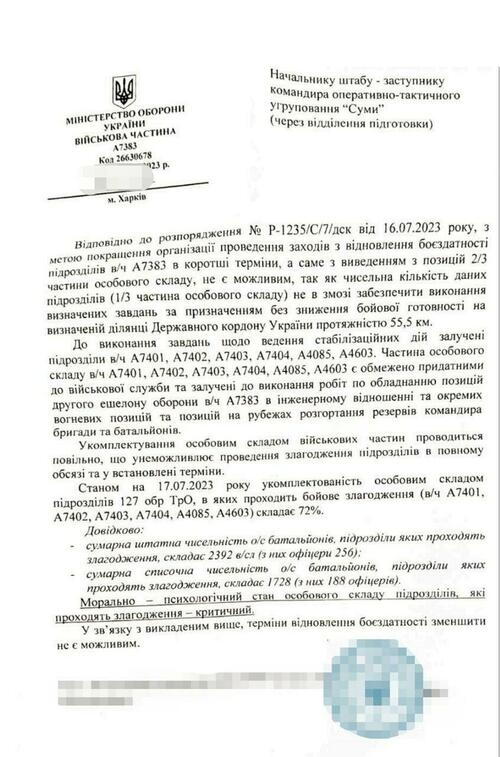
Evidence keeps piling up, via leaked reports, of an across-the-board breakdown in the Ukrainian frontlines...
Previously, we focused on the southern Zaporozhye front. Now let’s focus on Kharkov, in the northeast.
The attached document, fully verified for authenticity, is a July report to the Chief of Staff of the operational-tactical group “Sumy”.
The report essentially says that it’s impossible to withdraw two thirds of the A7383 unit from the battlefield to recover combat readiness because the remaining one third is incapable of holding the fort – which happens to extend along 55.5 km.
In parallel, recruiting was proceeding very slowly.
As of four months ago, the 127th separate territorial defense brigade in Kharkov was still equipped with 72% of personnel – 2,392 soldiers and 256 officers. Yet, crucially, the moral-psychological condition of the unit was critical – just as in the previous instance in Zaporozhye.
So forget about recovering combat readiness: this is yet another case of a brigade – now in Kharkov – that cannot fight properly. The previous case was far from being an exception to the current rule.
The conclusion is stark: with whole brigades in critical condition, the entire Ukrainian frontline may be about to fall.
The Hundred Days Debacle
Facts on the ground point to the Russian Armed Forces (RAF) taking the initiative all along the SMO frontlines. This is recognized even by Polish and Estonian intel. Main battles are being fought on the Avdeevka-Marinka line in the DPR and the Kupyansk-Svatovo line in the LPR.
RAF has enough manpower and weapons to keep the Ukrainians under a 24/7 state of despair. Objectives remain the same: to capture the whole of DPR and LPR within their administrative borders.
In parallel, the ever-unplugged Dmitri Medvedev, Deputy Chairman of the Russian Security Council, has announced a massive increase in the production of weapons and military equipment. Medvedev constantly stresses that the capabilities of the Russian defense industry have reached an unprecedented level – and much faster than expected.
Kremlin spokesman Dmitri Peskov, for his part, echoes what Foreign Minister Lavrov has been detailing for months now: Kiev – and its NATO handlers – better realize they cannot and won’t “win” in the battlefield.
Medvedev always relishes upping the ante: “The West must admit that not only Donbass and Crimea are not Ukraine, but also Odessa, Nikolaev, Kiev and practically everything else.”
That was a sharp response to former NATO Secretary- General Anders “Fogh of War” Rasmussen, who said that Kiev could be accepted into NATO “without lost territories,” referring to Crimea and Donbass.
That set Medvedev on a roll: “What then should we admit to NATO, you ask? Well, we can accept the city of Lemberg with its surroundings [the Lviv region] if they really insist there.”
This analysis focuses on “what the Russians are doing with their ongoing ‘mud season offensive’ in Ukraine, really a collection of local attacks across the length of the front line” – with the exception of Kherson.
Strategically, Russia has committed none of its own massive reserves while the Armed Forces of Ukraine (AFU) are pressured all along the frontlines – and the Russians silently prepare a surprise knockout blow elsewhere.
A Perfect Storm of dwindling financing, weaponizing and Western “support” has darkened Kiev’s horizon, while serial Ukrainian disasters on the ground are so obvious they are even being picked up by Western mainstream media.
This ain’t no “stalemate”.
The previous analysis is only one among many that matches the breakdown of Ukrainian brigades across the frontlines – consisting “largely of units already mauled in their disastrous Hundred Days Offensive.”
The Hundred Days Offensive should rather be qualified as NATO’s Hundred Days Debacle.
The debacle is the key reason why the “Biden combo” administration is now desperately trying to impose a ceasefire: a face-saving gambit as crucial as throwing the sweaty sweatshirt in Kiev under a double-decker bus.
Evidence keeps piling up, via leaked reports, of an across-the-board breakdown in the Ukrainian frontlines…
Previously, we focused on the southern Zaporozhye front. Now let’s focus on Kharkov, in the northeast.
The attached document, fully verified for authenticity, is a July report to the Chief of Staff of the operational-tactical group “Sumy”.
The report essentially says that it’s impossible to withdraw two thirds of the A7383 unit from the battlefield to recover combat readiness because the remaining one third is incapable of holding the fort – which happens to extend along 55.5 km.
In parallel, recruiting was proceeding very slowly.
As of four months ago, the 127th separate territorial defense brigade in Kharkov was still equipped with 72% of personnel – 2,392 soldiers and 256 officers. Yet, crucially, the moral-psychological condition of the unit was critical – just as in the previous instance in Zaporozhye.
So forget about recovering combat readiness: this is yet another case of a brigade – now in Kharkov – that cannot fight properly. The previous case was far from being an exception to the current rule.
The conclusion is stark: with whole brigades in critical condition, the entire Ukrainian frontline may be about to fall.
The Hundred Days Debacle
Facts on the ground point to the Russian Armed Forces (RAF) taking the initiative all along the SMO frontlines. This is recognized even by Polish and Estonian intel. Main battles are being fought on the Avdeevka-Marinka line in the DPR and the Kupyansk-Svatovo line in the LPR.
RAF has enough manpower and weapons to keep the Ukrainians under a 24/7 state of despair. Objectives remain the same: to capture the whole of DPR and LPR within their administrative borders.
In parallel, the ever-unplugged Dmitri Medvedev, Deputy Chairman of the Russian Security Council, has announced a massive increase in the production of weapons and military equipment. Medvedev constantly stresses that the capabilities of the Russian defense industry have reached an unprecedented level – and much faster than expected.
Kremlin spokesman Dmitri Peskov, for his part, echoes what Foreign Minister Lavrov has been detailing for months now: Kiev – and its NATO handlers – better realize they cannot and won’t “win” in the battlefield.
Medvedev always relishes upping the ante: “The West must admit that not only Donbass and Crimea are not Ukraine, but also Odessa, Nikolaev, Kiev and practically everything else.”
That was a sharp response to former NATO Secretary- General Anders “Fogh of War” Rasmussen, who said that Kiev could be accepted into NATO “without lost territories,” referring to Crimea and Donbass.
That set Medvedev on a roll: “What then should we admit to NATO, you ask? Well, we can accept the city of Lemberg with its surroundings [the Lviv region] if they really insist there.”
This analysis focuses on “what the Russians are doing with their ongoing ‘mud season offensive’ in Ukraine, really a collection of local attacks across the length of the front line” – with the exception of Kherson.
Strategically, Russia has committed none of its own massive reserves while the Armed Forces of Ukraine (AFU) are pressured all along the frontlines – and the Russians silently prepare a surprise knockout blow elsewhere.
A Perfect Storm of dwindling financing, weaponizing and Western “support” has darkened Kiev’s horizon, while serial Ukrainian disasters on the ground are so obvious they are even being picked up by Western mainstream media.
This ain’t no “stalemate”.
The previous analysis is only one among many that matches the breakdown of Ukrainian brigades across the frontlines – consisting “largely of units already mauled in their disastrous Hundred Days Offensive.”
The Hundred Days Offensive should rather be qualified as NATO’s Hundred Days Debacle.
The debacle is the key reason why the “Biden combo” administration is now desperately trying to impose a ceasefire: a face-saving gambit as crucial as throwing the sweaty sweatshirt in Kiev under a double-decker bus.
Loading…






